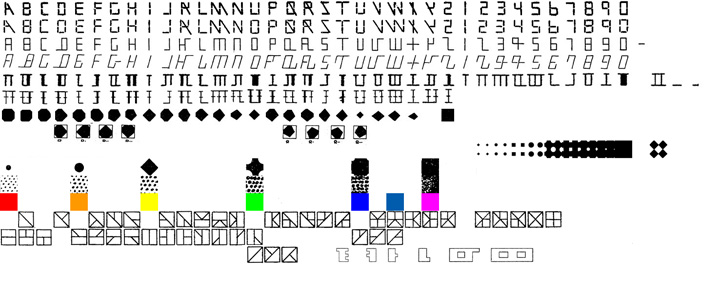|
telegraphic codes and message practice |
||

|
elementary signs : introduction |
Circa 1909-1915, patents were granted for printing telegraph devices that sought to increase printing speed by minimizing mechanical movements. This was done by using a small number of fixed (or only slightly) moving elements; whereby, for example, two, four, or six elements could be used to print all of the characters of an alphabet, plus numbers. These are what I mean by elementary signs : letters. Some of these were for purely mechanical printing (striking onto paper); others involved chemically treated paper and electrical charges. Remarkably, these systems utilized Baudot-like signals not only to signify letters and numbers, but to actuate the combination of two-to-six elements needed to assemble the printing characters themselves. In this way, they represent primitive instruction sets for letterforms. These same years, though extending well into the 1920s, saw several patents for means to analyze, code and transmit pictorial information for reproduction at the receiving end. The idea was to create a non-pictorial record of a picture — generally in the form of perforated tape — that captured grayscale values, and even hue and characteristics of zonal "edges," in code. They are distinct from other "semantic" means of characterizing and coding fingerprints, facial features, topographic and other "visual" data. I focus here on patents that evidence a gradual working out of the analysis, classification and "coding" itself, which might involve a human agent. Several of these specifications provided for reproduction of the scanned image, at the receiving (terminal) end, by the use of lead type (or typewriting devices) whose sorts were designed for picture reproduction. These several typographic and visual coding systems involved elementary signs at the terminal end. The review on these pages focuses for the most part on these elementary signs, rather than the mechanical workings of their respective systems. I do not know if these patents were ever successfully commercialized. My suspicion is that the type patents, and those picture telegraph patents involving lead type and manual "scanning," would both be superseded by other developments. For printing of letters, these advances would include the perfection of multiplex printing machinery. For picture or "copying" telegraphy, the improvements would involve photoelectric cells, lenses, and treated paper in a largely photochemical and increasingly automated process. The pace with which patents succeeded patents, even by the same inventor — H. E. Ives, the Bartlane patents, etc. — means that the patents aren't a useful guide to commercialized devices, although a group of patents might shed archaeological and even functional light on an actual machine. The survey covers several additional areas that are somewhat tenuously related to elementary signs and telegraphy. These are telautography, programmable electric display signs, and chess codes. The telautograph was a system whereby a stylus moved by hand, to form letters and words, or indeed any mark, at the sending station, actuated a pen at the receiving end to reproduce those movements, gesture by gesture. The operant means were a pantograph arrangement and signals — either of different strengths and polarities by means of a rheostats, or of sequential duration — that at the synchronous receiving end actuated magnets or geared mechanisms with escapements, to control a writing pen. The system involved no "elementary signs" but is included in this survey for reasons of (1) due diligence and (2) because "telautograph" was occasionally used interchangeably with "copying" or "photo" telegraphy in the patent literature. The electric signs covered in a separate page were designed to display a succession of letters and other forms using the same set of elemental shapes; in some cases, their mechanisms are controlled by perforated tape. These are somewhat out of place in this discussion of elementary signs in telegraphy, yet they : (1) are composed of elementary signs; (2) are electrical; (3) are programmable via perforated tape or other switching mechanism; and (4) in the case of Hildburgh in particular, were developed by electrical engineers with some connection to telegraphy. Two chess codes are briefly considered as special means of describing trajectories, and enclosed and open areas. One of these in particular, by employing the functions of each chess piece in its dictionary of functions, works as a "chain signal code" that can describe an object boundary as a series of direction codes. Each chess piece has a repertoire of functions, and is thus akin to a elementary sign. In order to shorten pageload time, these notes have been divided into several sections per these links:
margins : chess codes
|